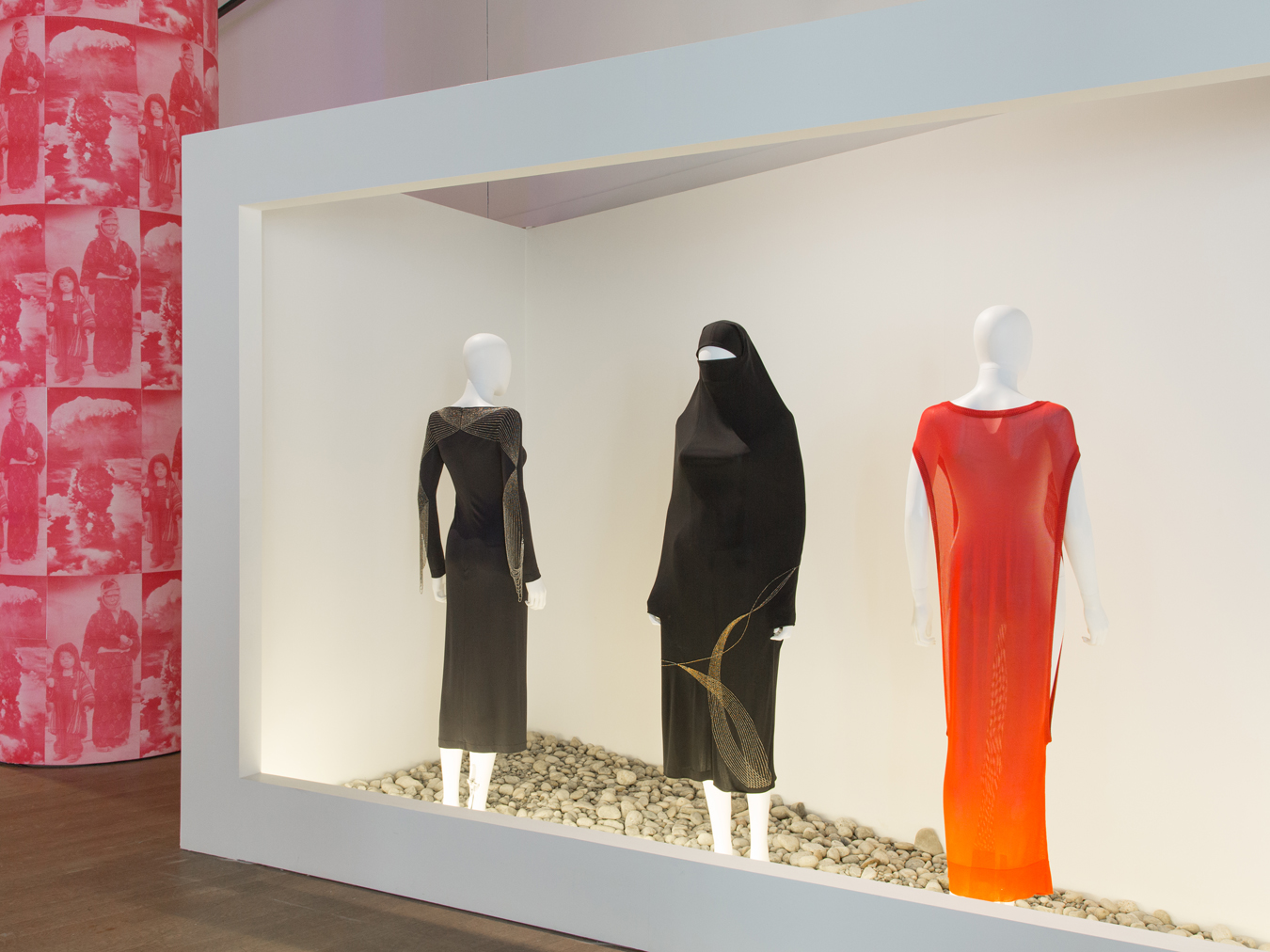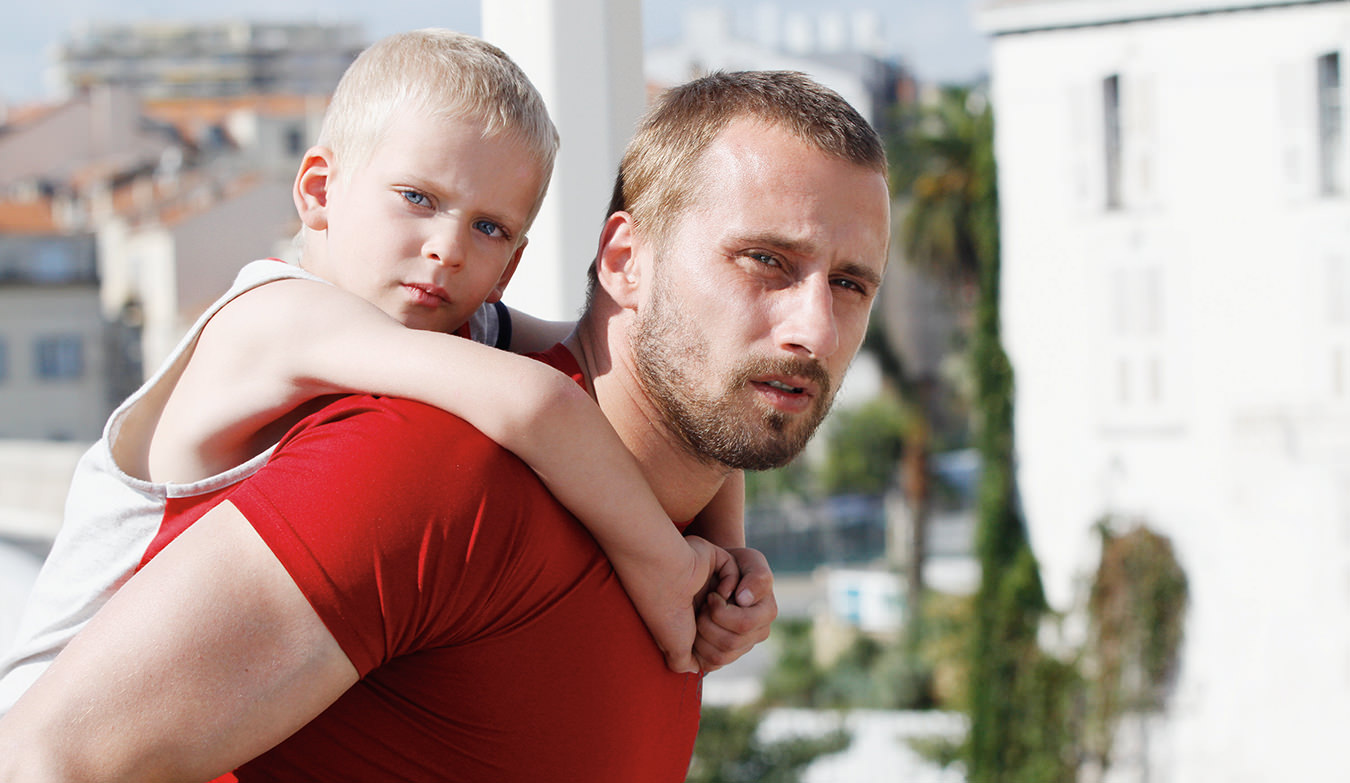-

Artisanal Opera Coat, 2013, Maison Martin Margiela, sequins, wool, mohair, wool-silk, satin blend, pongee silk lining, mother of pearl sequins; from the collection of Maison Martin Margiela.
-

Unisex Maxi Coat, #12, Rad Hourani; from the collection of Rad Hourani.
-

Japanese designs by Yohji Yamamoto, Comme des Garçons, and Issey Miyake; from the collection of Jeremy Laing, Sylvia Mantella, and the Right Honourable Governor General Adrienne Clarkson.
-

Hussein Chalayan’s Between collection, 1998; from the collection of Hussein Chalayan.
-

A look from Diesel’s autumn/winter 2014 collection, button-up shirt, jeans, denim jacket, tie; from the collection of Diesel Venice.
-

Arab Spring Look 22, 2013, Jeremy Scott, leopard print sequined burqa, leather hat, mesh skirt, thigh high boots; from the collection of Jeremy Scott.
-

Jumpsuit with Gold Detail, 2012, Moschino, cotton, synthetic, metal; from the collection of Sylvia Mantella. McDonald’s Dress, 2014, Moschino, silk, visor, leather purse and plastic tray; from the collection of Moschino.
-

White Gown with Smoke Detail, 2010, Alexander McQueen, silk; from the collection of Stacey Jordan. Gold Metal Bolero, 2010, Alexander McQueen, metal, beading; from the collection of Stacey Jordan.
-

A section featuring punk style, with designs by Vivienne Westwood and Malcolm McLaren; from the collection of PunkPistol and Vivienne Westwood and Malcolm McLaren, Seditionaires.
-

Hussein Chalayan’s Afterwords collection, 2000; from the collection of the Grand Duke Jean Museum of Modern Art in Luxembourg.
-

Woodstock print pantsuit, 1970, unknown designer, denim; from the Fashion History Museum collection.
-

Blue shell and skirt, 2011, Nikki Lang, wool; from the collection of Laureen Harper.
-

A section with garments worn by Margaret and Pierre Trudeau in the 1970s; from the collection of Margaret Trudeau, the estate of Pierre Trudeau, and the collection of Alexandre Trudeau.
-

Black Fur Coat with Feathers, 2010, Alexander McQueen, silk, feathers, fur; from the collection of Stacey Jordan.
Fashion and Politics
Sending a message.
“Many contemporary philosophers say that consumerism is the biggest ethical battle of our times,” says Sara Nickleson, associate curator at the Design Exchange in Toronto, as she walks through a sea of white mannequins just days before the opening of the design museum’s new exhibition Politics of Fashion | Fashion of Politics. The array of stunning garments hanging on them—arresting in design and construction, as well as subject matter—reference a range of issues addressed by fashion from the 1960s to present day.
Fashion has long been a medium for social commentary and activism, and seeing such a diverse, politically-charged collection in one room is powerful. This new exhibition, guest curated by fashion industry veteran Jeanne Beker, runs until January 25, 2015, showcasing famous pieces from the likes of Jeremy Scott, Mary Quant, Yohji Yamamoto, Issey Miyake, Rei Kawakubo of Comme des Garçons, Maison Martin Margiela, Alexander McQueen, Stella McCartney, and Vivienne Westwood, to name a few.
“The Hussein Chalayan pieces in particular are remarkable,” says Jeremy Laing—who designed the exhibition layout—referencing Chalayan’s Afterwords collection, which was inspired by the horror of having to leave one’s home at the time of war and the desire to take one’s possessions when displaced. He created a living room wherein chair covers turned into clothes and chairs into suitcases; the presentation provoked a powerful response. “The fact that fashion shows can be like this was very exciting for me as a young person,” says Laing. “There’s a reason why that worked and continues to be shown, because it’s an important cultural artifact.” The living room set is on display in the exhibition.
Fashion in politics, the latter half of the exhibition’s focus, also plays an important role. “It’s crazy, when you look at First Wives, because women especially are picked apart,” says Nickleson. “Get on Google and look up Michelle Obama’s style, and there’s so much commentary about what she wears.” Indeed, choices of attire—the colour of a suit, the brand of a cardigan, the cut of a dress—are picked apart by pundits, and what politicians wear can dictate the way people view what they’re saying. “This section of the exhibit is more about choices, rather than someone creating something for the purpose of a message, but at the same time those choices really do have impact.” Nickleson references Trudeau’s denim-on-denim Canadian tuxedo, and Laing points out an anorak worn by Prime Minister Stephen Harper, which was given to him by an Inuit community earlier this summer. “It’s a blue windbreaker but in the form of a traditional sealskin Inuit anorak. It’s a really interesting garment.”
Other important facets of the exhibition are the subcultures presented—hippies, punks, skinheads—which focus more on grassroots movements rather than a specific designer. “The hippie movement was really done by the youth,” says Nickleson. “A lot of it is handmade and more patched together.” Laing’s exhibition design creates an overall guerrilla aesthetic, with backdrop images like controversial United Colors of Benetton ads and graphic posters covering the walls. “We wanted to make it approachable in how it was all treated,” he explains.
These sections in particular raise important questions about conveying political messages through fashion today. “People make political statements every day without realizing it,” says Laing. “The world by and large passively agrees on what a man or woman looks like and how they dress, but the things we believe to be 100 per cent true have not always been so.” Indeed, designers like Canadian Rad Hourani are redefining these norms through unisex attire, and this is just one of many issues addressed in the exhibition. “We’re all about showing the way design intersects, and this is an important intellectual conversation to have,” says Design Exchange president Shauna Levy. “Fashion as a viewfinder for political events.”




